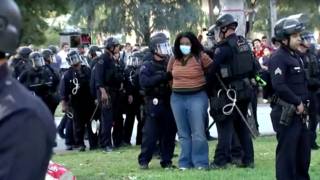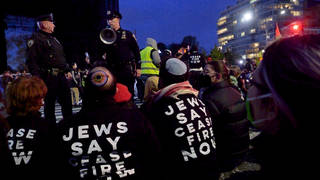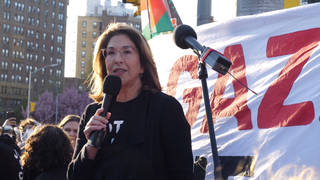
Related
On September 7, armed attackers seized Italian humanitarian workers Simona Torretta, Simona Pari and their Iraqi colleagues, Mahnouz Bassam and Raad Ali Abdul Azziz. Nothing about this kidnapping fits the pattern of other abductions, from the sophisticated weapons to the clean-shaven man in charge that the others called, “sir.” We’ll speak with correspondent Jeremy Scahill. With Naomi Klein, he wrote an investigative piece for The Guardian of London on the case. [includes rush transcript]
Two Americans and a British citizen were abducted in Baghdad today, according to the Iraqi interior ministry. A spokesman said that gunmen seized the men at dawn from a house in the capital’s Mansour neighborhood–a wealthy residential area on the river Tigris, where many multinational companies have their headquarters.
The men were reportedly bundled into a minivan and driven away without a fight. They were employees of Gulf Services Company, a Middle East-based construction firm. This according to the BBC.
This latest kidnapping brings the number of foreigners in Iraq currently being held to 20. What is virtually unreported by the international media is the kidnapping of Iraqis for ransom which has become commonplace, particularly in Baghdad.
The kidnapping of the US and British citizens follows the abduction of two Italian and two Iraqi humanitarian workers last week. The women, Simona Torretta and Simona Pari were abducted from their Baghdad office on September 7th along with their Iraqi colleagues Raad Ali Abdul Azziz and Mahnouz Bassam. The four worked at “A Bridge to Baghdad”–the longest standing non-governmental organization operating in Iraq.
This is an excerpt of an interview recorded in February with Simona Toretta–one of the Italian hostages. It was recorded by filmmaker and activist Francis Anderson. This is Simona Torretta.
- Simona Torretta, being interviewed in February 2004. Courtesy of Francis Anderson.
An investigative article by Jeremy Scahill and Naomi Klein in the Guardian (UK) raises questions about the kidnapping of the two Italian and two Iraqi humanitarian workers last week.
- READ THE GUARDIAN ARTICLE: * “”:http://www.guardian.co.uk/comment/story/0,3604,1305523,00.htmlWho seized Simona Torretta?*
- Jeremy Scahill, producer and correspondent for Democracy Now!
Transcript
AMY GOODMAN: Simona Torretta speaking last February.
SIMONA TORRETTA: So we reached Baghdad at 9:00 or 10:00. And when we reached Baghdad, there was the bombings. It was first impact was very hard. Very hard. I couldn’t recognize Baghdad at all.
FRANCIS ANDERSON: Were there bombings happening as you were driving in?
SIMONA TORRETTA: Yes. Yes. Me, last time that I was in Baghdad was one month ago. I found everything changed. Everything changed. I couldn’t recognize Baghdad this time. All of the shops totally closed. The city empty, dark, smoke everywhere. When I met my friends, they were just so surprised to see me, you know? They said, “Why are you coming here? It’s so dangerous for you. Go back in Italy. What are you doing here? Why you came? Are you crazy?” I say, okay, I cannot stay in Italy. I decided to come here because it’s part of my life.
AMY GOODMAN: Simona Torretta recorded last February. She along with her three colleagues were abducted September 7th in Baghdad. In today’s British Guardian, Jeremy Scahill has a piece with Naomi Klein, it’s headlined, “Who Seized Simona Torretta?” This Iraqi kidnapping has the mark of an undercover police operation. Jeremy Scahill, Democracy Now! producer and correspondent, joins us in the studio. Welcome.
JEREMY SCAHILL: Thank you, Amy and Juan.
JUAN GONZALEZ: Jeremy tell us about this kidnapping and what in terms of what you have discovered makes it different from many of the other kidnappings we have seen in Iraq?
JEREMY SCAHILL: I think to answer that first we have to look at who are the people that have been taken. Simona Toretta, Simona Pari, Raad Ali Abdul Azziz and Mahnouz Bassam were people who had dedicated their lives not just to bringing humanitarian relief to people in Iraq but to taking a strong stance against the sanctions when Saddam Hussein was president, against all bombings and attacks on Iraq, against the invasion of Iraq, and against the occupation of Iraq. These also were deeply political people. Simona Torretta and A Bridge to Baghdad, they were some of the key organizers of the large demonstrations on February 15 in Italy, enormous demonstration, political opponents of the regime of Silvio Berlusconi, and they were the longest serving organization, N.G.O. in Iraq. They were there since 1992, very shortly after the so-called Gulf War ended. The reason why that’s significant is because after the so-called Gulf War, almost no international organizations would operate in Iraq because of the sanctions, and this was a group that defied that. It was the group that inspired Voices in the Wilderness, the U.S.-based anti-sanctions campaign, to take up its work. And so, what they were doing, under the occupation, was essentially defying the occupation regime. When the city of Fallujah was under siege in April, Bridge to Baghdad defied the U.S. sealing off of the city. They brought humanitarian supplies and stood in solidarity with civilians who were caught in the middle of the U.S. onslaught. Remember that what sparked the siege of Fallujah was the gruesome killing of the four Blackwater mercenaries. Brigadier General Mark Kimmitt threatened to crush the city and punish the entire city. He said that the campaign would be methodical and it would be overwhelming. They were there during that campaign. They were witnesses of it. When U.S. Marines laid siege to the holy city of Najaf in August, again A Bridge to Baghdad went where they were not supposed to go. They brought 250,000 gallons of water into the city. Water supply for people who were caught in the middle of the fighting. So, on September 7, when armed gunmen took them, a number of questions were raised by who would benefit from seizing these people. The way that it went down was about 5:00 in the afternoon. A convoy of five cars pulls up on the street. Their office is next to a hospital, only blocks away from the green zone which houses the U.S. occupation authority in the form of the U.S. Embassy, as well as the Iraqi Governing Council. Gunmen get out of the cars, some of them not wearing masks at all, clean-shaven, business suits. They stop traffic on both sides of the street very much like a law enforcement operation. And witnesses — in fact, we had some of the reports, eyewitness reports translated from Arabic into English — many of the eyewitness reports say that people thought this was a police operation because they were being stopped by men in uniforms. Several of the men were identified as having Iraqi National Guard uniforms on, which is significant. I’ll talk about that in a second. But they block off the street. Two men approach the Bridge to Baghdad office and they have pistols with silencers and a stun gun. I have never seen a stun gun in Iraq. I have never seen a pistol with a silencer. I have never heard of those weapons being used by anyone within the Iraqi resistance. They say to the unarmed guards, really the doorman at A Bridge to Baghdad, that they’re from the office of Prime Minister Iyad Allawi. They proceed then to force their way into the building. They don’t just take the first people that they see. They are asking for Simona Torretta and Simona Pari by name. And when Mahnouz Bassam comes out to protest in the hallway, they grab her by her hejab, by her head scarf, and drag her from the building. This is an enormous religious transgression, for a woman to be grabbed by the head scarf that is on her head to cover her hair, and to drag her in front of witnesses into a car and throw her there. I was talking to a friend of mine last night, who is a Muslim, and I said, “If this were to happen in a marketplace somewhere, what would happen?” He said, “They would be beaten probably to death for doing it.” So they drag her out. They also take Raad Ali Abdul Azziz and the two Simonas, put them in their cars which included land cruisers, and they drive them off. 15 minutes later, a convoy of U.S. humvees comes whizzing by from the direction that they had fled in, so it was coming from the opposite direction. This was an incredibly bold operation. It was very well coordinated. It took place just blocks away from the green zone. So whoever pulled this off would have had to have had the confidence they were going to be able to abduct these people in a very precise manner, without a threat from the outside. And a number of questions are raised also by the fact that they identified themselves as representing the office of the unelected interim Prime Minister Iyad Allawi. Iyad Allawi himself is a spook, a lifelong spook. He was a Ba’ath Party assassin for Saddam Hussein, bumping off enemies of the regime in Europe. He was a Muhabarat, one of the feared secret police in Iraq. After his break with Saddam, he went on to work with MI-6, the British intelligence, the Saudi intelligence and has connections to the Central Intelligence Agency. One of the key components of the iron-fisted Iraqi interim government regime right now is that they have taken so many of the thugs that worked for Saddam Hussein and put them on the Iraqi government payroll. The United States has done the same. They have hired people who were repressing, torturing, abusing Iraqis under Saddam Hussein, and they played the exact same role in the current Iraq. Many of the witnesses to this abduction said that it reminded them of the days of Saddam Hussein’s Muhabarat. I heard when I was in Iraq, particularly in 2002, so many stories about people being snatched from their homes, taken away, disappeared, never to be heard from again. And this has a lot of similarities to that.
JUAN GONZALEZ: But, clearly, I mean, the uniforms could have been stolen, and while I agree with you that the weaponry seemed more advanced than your normal resistance fighters, is there any other indication, that for instance, has any group claimed responsibility for what’s been the reaction of other resistance groups within Iraq?
JEREMY SCAHILL: Two groups have claimed responsibility. One on the — shortly after the abductions happened, and then another one identified as Ansar al-Zawahiri, supposedly named after the number two man in al Qaeda. But these groups were basically unknown in Iraq. And the statements were not posted in any kind of — in that world, in any kind of credible way. They were posted on internet chat rooms on Arabic websites. It wasn’t like they posted them as this big declaration with video and photos. They were posted in a chat room that anyone could have had access to. There’s been no photographs, there’s been no video whatsoever. What I think is also significant is that according to one of the leaders of the most important Sunni cleric organization in Iraq, Sheikh al-Kubaisi, the women came and met with him the day before they were kidnapped.
AMY GOODMAN: The two Simonas.
JEREMY SCAHILL: The two Simonas and Raad Ali Abdul Azziz. They came and met with him at the Mother of All Villages Mosque in Baghdad, it’s a gigantic Sunni mosque. And they were explaining to him that they were planning to begin another aid operation into Fallujah. There are some reports that indicate that they told him they wanted to refocus their work on the city of Fallujah. They had been there before. He is one of the main people who can facilitate getting in and out of Fallujah. He also is someone who has successfully negotiated hostage releases in the past. So they went and they met with him and they told him that they were being threatened, and that people were pressuring them to change the nature of their work. He refused to say who it was that was threatening them. He said for their safety. But he said that no Iraqi group did this. That no Iraqi resistance group did this, and suggested that it was done by foreign intelligence services. Now, C.I.A. Mossad conspiracies run rampant all over Baghdad, as they do in any kind of a conflict area. But coming from him, it carries a bit more weight because of his involvement and connections to resistance groups. The other key factor here is that these kidnappings have sparked more of an outcry and an outrage from Islamic groups not just in Iraq but around the world who support violent resistance in Iraq itself. Hezbollah has called for their release. Islamic jihad has called for their release. The Algerian Islamic leader, Abbas Madani, has announced a hunger strike to the death for their freedom, from Qatar, where he is in exile. A resistance group in Fallujah released a statement saying they should be released, whoever did this is against the noble and honest resistance of Iraq and is working for foreign forces bent on keeping Iraqi soil away from Iraqi power. So, you have this enormous response from many groups who support jihad or uprising in Iraq.
AMY GOODMAN: Interesting you point out a Newsweek piece that opens with a description of the abduction. An English word is used.
JEREMY SCAHILL: Yes. Another thing about this pristine operation, which according to —
AMY GOODMAN: We only have one minute.
JEREMY SCAHILL: According to an Iraqi journalist who witnessed the scene, happened to be in the area, the whole thing took less than five minutes. The abduction. Some say ten minutes. What’s interesting is Newsweek and others reported — they quoted eyewitnesses saying that there was one man that was in charge, a clean-shaven man in a gray suit who the others referred to as “Sir.” I think that we don’t know who took these women, but the point is that there are people who know who have these women, and we cannot rule out the possibility that it was not an Iraqi resistance group. This hurts the Iraqi resistance tremendously, and you always have to ask who benefits in cases like this.
AMY GOODMAN: This last point that they were going to even rename their group or a sub-grouping?
JEREMY SCAHILL: Yeah. That’s what Sheikh al-Kubaisi said, he said that they were considering renaming their organization, Fallujah Emergency, but that is something that people close to them doubt and they believe they simply wanted to start a program of bringing aid into Fallujah.
AMY GOODMAN: And really focusing on Fallujah.
JEREMY SCAHILL: Focusing on Fallujah where the United States is again launching a major offensive.
AMY GOODMAN: Website for people to get more information, of course, democracynow.org.
JEREMY SCAHILL: You can go to freeourfriends.blogspot.com, and that’s a site that’s compiling a lot of information, and then on our website, we’re going to post this article and others.
AMY GOODMAN: And the article that Jeremy Scahill wrote with Naomi Klein is in today’s British Guardian called, “Who Seized Simona Torretta?” Thank you very much, Jeremy.
JEREMY SCAHILL: Thank you.
AMY GOODMAN: Jeremy Scahill, DemocracyNow! correspondent.











Media Options